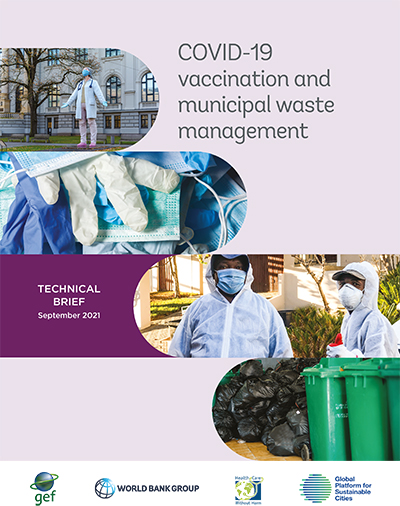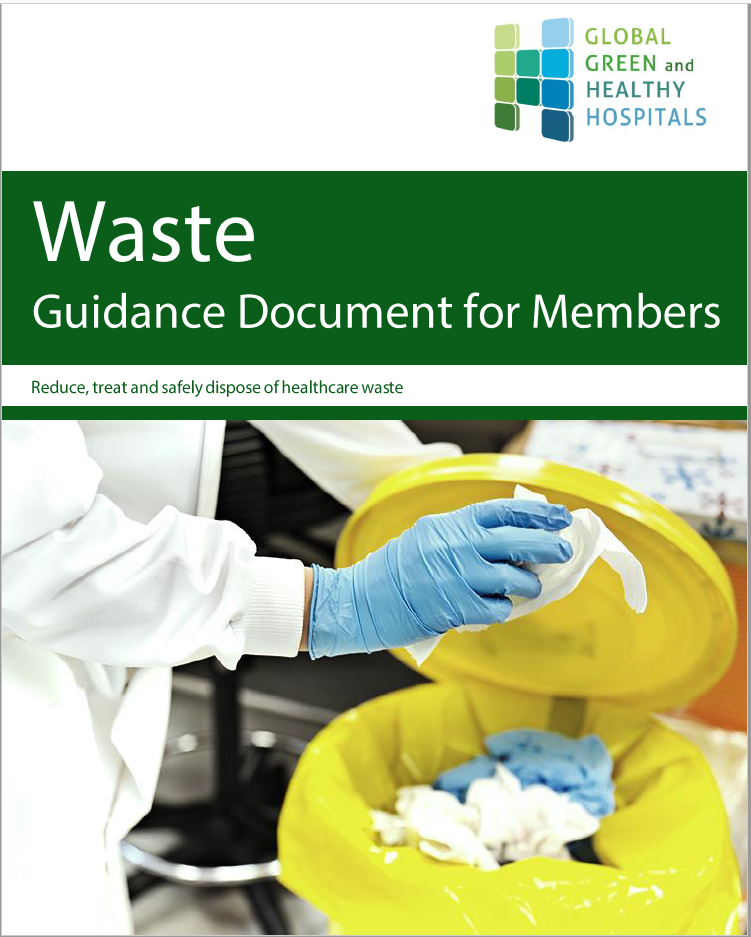Health care waste management resources
- Data collection tools and calculators
- Comprehensive advice and guidelines
- Hazards of healthcare waste, status of management
1. Data collection tools and calculators
Health Care Without Harm - Health care waste trackers: Health Care Without Harm and HECAF360 developed six tracking tools for health care facilities to understand and control their waste management. Each tracker is specially designed for a different stage of the waste management process, and they may be filled in by different people playing different roles in the system. Optimized for daily data entry, the tracker produces clear summary tables and graphs that a waste manager, waste management committee, or facility director can quickly view to assess system performance and make informed decisions.
3. Advice and guidelines
Reducing mercury release and UPOPs in Africa: UNDP in partnership with WHO and Health Care Without Harm developed and implemented the project called "Reducing UPOPs and Mercury Releases from the Health Sector in Africa". This 4-year initiative led to the implementation of best environmental practices, the establishment of non-burn health care waste treatment technologies, and the introduction of mercury-free medical devices in four sub-Saharan African countries: Ghana, Madagascar, Tanzania, and Zambia. All the resources, guidelines, and best practices produced during this project are available on the Green Healthcare Waste site.
General documents:
Managing health care waste in Nepal - Brochure for hospitals
Health Care Without Harm and HECAF360 partnered in a health care waste management project in Kathmandu, Nepal, funded by the German Corporation for International Cooperation (GIZ). The goal of the project is to strengthen health care waste management at the project hospitals, help build capacity for monitoring and reporting of health care waste management. and share learning and innovations arising from the project. This brochure was designed to introduce staff at the hospitals to health care waste management, and its importance for both institutions and communities. [English] [Nepali]
COVID-19 vaccination and municipal waste management
Health Care Without Harm and the World Bank published on 2021 a briefing aimed at urban authorities, including those responsible for general waste disposal, addresses all aspects of the issue from how to reduce PPE waste to the potential for recycling vaccination waste, and turning it instead into a resource.

The rollout of COVID-19 vaccination is the largest immunization campaign in human history and is generating an unprecedented quantity of vaccination waste, including used syringes, vials, plus packaging and the swabs and PPE used by the vaccinators. With the experience of healthcare waste management systems being swamped by infectious waste at the start of the pandemic, and many vaccination drives being held away from healthcare facilities, there is significant potential for this waste to cause problems for municipalities, ranging from the spread of infection to increased CO2 emissions.
GGHH waste guidance document
 Accessible to members of the Global Green and Healthy Hospitals network, the GGHH Waste Guidance document sets out ways to meet the target of reducing, managing and treating waste in the most sustainable way considering that the different situations found in different countries will mean there is no perfect solution that will suit all circumstances. For more information about how to join GGHH, click here.
Accessible to members of the Global Green and Healthy Hospitals network, the GGHH Waste Guidance document sets out ways to meet the target of reducing, managing and treating waste in the most sustainable way considering that the different situations found in different countries will mean there is no perfect solution that will suit all circumstances. For more information about how to join GGHH, click here.
Specific documents:
These documents were created with funding from the US Centres for Disease Control:
- Health Care Waste Management Training - Guidance.
- Health Care Waste Management Prophylaxis Guidance.
- Health Care Waste Management Worker PPE - Guidance.
- Department Training Record.
- Employee Training Record.
- Training Program Attendance Log.
- Waste Minimization and Recycling Of Infectious Waste - Guidance.
- On-site Handling of Health Care Waste - Guidance.
- On-Site Handling and Transport of Infectious Waste for Housekeeping Staff - SOP.
- Facility Health Care Waste Management Plan - Guidance.
- Facility Waste Management Oversight Committee - Guidance.
- Health Care Waste Management Budget Planning - Guidance.
- Model HCWM Systems for Each Facility Type.
- Management of Offsite Infectious Waste Transportation, Treatment, and Disposal Service Provider ‒ Guidance.
- Health Care Waste Management Audit Procedures - Guidance.
- Inspection Checklist: Housekeeping/Waste Handler.
- Inspection Checklist: Waste Holding and Storage.
- Inspection Checklist: Laboratory Waste Management.
- Inspection Checklist: Supervisor/Matron.
- Audit Checklist: Autoclave Operation.
- Biological Spill Clean-up - SOP.
- Incident Reporting Form.
- Incident Log.
- Autoclave Inspection and Routine Maintenance - SOP.
- Shredder or Grinder Maintenance Checks - SOP.
- Autoclave Validation and Challenge Testing - SOP.
- Autoclave Maintenance Log.
- Technical specifications: Ash Pits.
- Technical Specifi cations: Organic Waste.
- Technical Specifications: Biogas Digesters.
- Technical Specifications: Placenta Pit.
- Elements of a Model Facility Policy on Healthcare Waste Management.
- Audit Checklist: Incinerator Operation.
- Health Care Waste Management Training - Guidance.
- Health Care Waste Management Prophylaxis Guidance.
- Health Care Waste Management Worker PPE - Guidance.
- Department Training Record.
- Employee Training Record.
- Training Program Attendance Log.
- Waste Minimization and Recycling Of Infectious Waste - Guidance.
- On-site Handling of Health Care Waste - Guidance.
- On-Site Handling and Transport of Infectious Waste for Housekeeping Staff - SOP.
- Waste Receipt Log.
- Sanitary Sewer Disposal of Liquid Laboratory Waste - Guidance.
- On-site Treatment and Disposal of Blood Transfusion.
- Chemical Waste Management - Guidance.
- Chemical Decontamination of Laboratory Wastes - SOP.
- Chemical Treatment Log.
- Disposal of Filled Blood Bags by Autoclaving - SOP.
- Autoclave Operation - SOP.
- Autoclave Operation Log.
- Autoclave Validation and Challenge Test Log.
- National Assessment Tool-final.
- Waste Treatment System Evaluation.
3. Hazards of health care waste - Status of management
Health care waste management in low- and middle income facilities: Less than half of health care facilities in low and middle income countries have adequate waste management and in some areas, there are no data at all.
- WHO & UNICEF (2015) Water, sanitation and hygiene in health care facilities. Status in low- and middle-income countries and way forward. http://apps.who.int/iris/bitstream/10665/154588/1/9789241508476_eng.pdf?ua=1
Impacts of improperly treated health care waste: This review of scientific literature estimated that half of the world’s population are at risk from environmental, occupational or public health threats from improperly treated healthcare waste.
Harhay et al 2009 Health care waste management: a neglected and growing public health problem worldwide. Tropical Medicine and International Health 14(11):1414-1417. http://onlinelibrary.wiley.com/doi/10.1111/j.1365-3156.2009.02386.x/pdf
Human rights and health care waste: In 2011, the UN Human Rights Council Special Rapporteur invited HCWH to provide input about the way in which improper medical waste management might harm human rights. The following report, and input from other agencies including WHO, led to a final report recommending more support for medical waste management and the substitution of incineration wherever possible.
- Stringer, R. et al. (2011) Medical Waste and Human Rights Submission to the UN Human Rights Council Special Rapporteur. Publ: HCWH, 68pp.
- Georgescu, C. (2011) Report of the Special Rapporteur on the adverse effects of the movement and dumping of toxic and dangerous products and wastes on the enjoyment of human rights. Publ: Human Rights Council Eighteenth session Agenda item 3, Promotion and protection of all human rights, civil, political, economic, social and cultural rights, including the right to development, 21pp.
Mercury waste assessment: Country by country analyses of the status of waste management in general and mercury in particular.
- UNEP (2017) Global Mercury Waste Assessment: Review of Current National Measures. https://www.unep.org/ietc/sites/unep.org.ietc/files/Global-Mercury-Waste-Assessment-web.pdf
